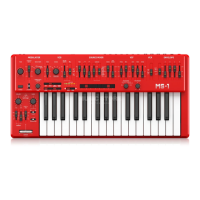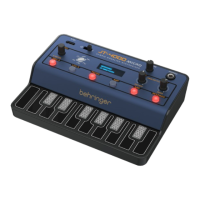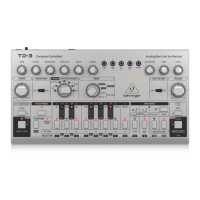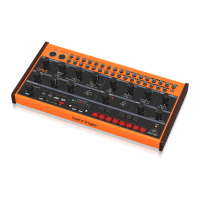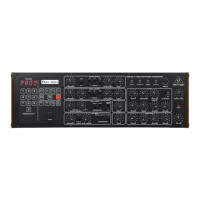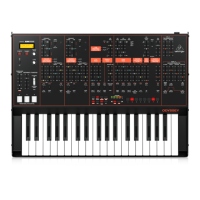20. ENV – adjust the amount of effect the envelope has on the VCF.
21. MOD – adjust the amount of effect the modulation has on the VCF.
22. KYBD – adjust the amount of effect the keyboard has on the VCF.
23. FM SOURCE – select the source of FM modulation on the VCF from: pulse, sawtooth, 1 octave down square wave, 2 octaves
down square wave, 2 octaves down pulse, and noise.
24. FM AMOUNT – adjust the effect of FM modulation on the VCF.
VCA Section
25. ENV/GATE – select if the VCA is affected by the envelope controls, or by gate.
Envelope Section
When applied to the VCA, the ADSR envelope is used to control the level of the note being played over time. When applied to the
VCF, the ADSR envelope is used to control the cut-off frequency of the filter for each note played over time. In addition, the ADSR
envelope can also affect the VCO pulse width modulation. Note that the ATTACK, DECAY and RELEASE stages are measured in
units of time, and the SUSTAIN stage is measured in units of level.
26. GATE + TRIG – a new envelope is triggered at each key press. GATE – when a new note is pressed, a new envelope is trigged
after the current one is done. LFO – the envelope is triggered by the LFO.
27. A-ATTACK – this adjusts the time for the level to reach maximum after a key is pressed.
28. D-DECAY – this adjusts the time to decay down to the SUSTAIN level after the attack time is over.
29. S-SUSTAIN – this sets the sustain level reached after the attack and decay time are over.
30. R-RELEASE – this adjusts the time it takes for the signal to decay once the key is released.
Control Section
31. VOLUME – adjust the volume level of the main output and headphones output. Turn this down before turning the power on, or
before putting on headphones.
32. GLIDE – adjust the amount of Glide time (Portamento) between notes on the keyboard.
33. GLIDE ON/OFF – turn the GLIDE on or off.
34. TRANSPOSE – adjust the keyboard in one octave steps, from Low, Medium, and High.
35. VCO FADER – adjust the effect of the bender controls on the VCO.
36. VCF FADER – adjust the effect of the bender controls on the VCF.
37. LFO MOD FADER – adjust the amount of LFO modulation added when the MOD switch on the grip is pressed, or the BENDER
(38) is moved up.
38. BENDER – move left or right to adjust the frequency of the VCO and/or the cut-off frequency of the VCF. The level of the effect
depends on the setting of the nearby VCO and VCF faders. Move it up to add LFO modulation. The modulation effect depends upon
the setting of the LFO MOD fader and other LFO controls.
Rear Panel
39. DC INPUT – connect the supplied DC power adapter here. The power adapter can be plugged into an AC outlet capable of
supplying from 100V to 240V at 50 Hz/60 Hz. Use only the power adapter supplied.
40. MAIN OUTPUT – connect this output to the line-level inputs of mixers, keyboard amplifiers, or powered speakers for example.
41. PHONES – connect your headphones to this output. Make sure the volume is turned down before putting on headphones.
42. EXT AUDIO INPUT – this input can be connected to the line level audio output from an external audio device. Adjust the level using
the EXT AUDIO fader in the SOURCE
MIXER section.
43. HOLD – an optional footswitch can be connected here, to hold or release any pattern playing in the Sequencer, and in normal
performance.
44. VCF CV INPUT – the VCF can be controlled by an external control voltage connected here.
45. EXT CLK INPUT – an external clock signal can be applied here.
46. CV/GATE INPUT – these inputs allow the connection of control voltage and gate signals from compatible external devices such as
modular synthesizer equipment.
47. CV/GATE OUTPUT – these outputs allow the connection of control voltage and gate signals to compatible external devices such
as modular synthesizer equipment.
48. VELOCITY OUT – outputs a variable control voltage based on the key velocity.
49. MIDI Connections – these 3 standard 5-pin DIN Jacks allow connections to other MIDI equipment in your system.
MIDI IN – receives MIDI data from an external source. This will commonly be another MIDI keyboard, an external hardware
sequencer, a computer equipped with a MIDI interface, etc.
MIDI THRU – passes through MIDI data received at the MIDI INPUT.
MIDI OUT – sends MIDI data to an application
50. USB PORT – This USB type B jack allows connection to a computer. The MS-1 will show up as a class-compliant USB MIDI
device, capable of supporting MIDI in and out.
USB MIDI IN – accepts incoming MIDI data from an application.
USB MIDI OUT – sends MIDI data to an application.
51. GRIP/ MOD – the connector of the live performance grip attaches here. Live Performance Kit
52. BENDER – adjusts the frequency of the VCO and/or the cut-off frequency of the VCF. The level of the effect depends on the setting
of the VCO and VCF Bender faders. This control only increases the frequency. The main unit bender can also be used at the same
time.
53. MOD – press and hold to add LFO modulation. The level of effect depends upon the setting of the LFO mod fader, and the other
LFO controls.
54. CONNECTOR – fit into the GRIP and MOD connectors in the main unit rear panel.
55. MOUNTING HOLES – fit the supplied screws in these holes to secure the handle to the left side of the main unit.
56. STRAP POINT 1 – connect one end of the supplied strap here.
57. STRAP POINT 2 – secure this to the right side of the main unit with the supplied screws.
58. STRAP – the supplied strap attaches to the 2 strap points.
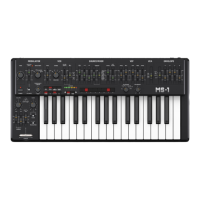
